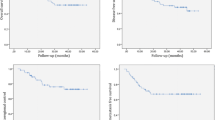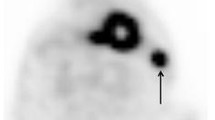Abstract
Purpose
We compared 3'[F-18]fluoro-3'-deoxythymidine (FLT) positron emission tomography (PET) and 2-deoxy-2-[F-18]fluoro-D-glucose (FDG) for PET visualization of head and neck squamous cell cancers (HNSCCs) and evaluated which might better reflect proliferative activity as indicated by the Ki-67 index.
Procedures
A total of 43 patients with HNSCCs were examined with FLT-PET and FDG-PET. The PET images were evaluated qualitatively for regions of focally increased metabolism and for semiquantitative analysis the maximum standardized uptake value (SUV) was calculated.
Results
For depiction of primary tumours, the sensitivity of both approaches was 100%. The mean (±SD) SUV for FLT (5.65 ± 2.96) was significantly lower than that for FDG (10.9 ± 4.91; p < 0.0001). No significant differences were found for the T category. However, the mean (±SD) FLT SUV was significantly higher in poorly than in well-differentiated tumours (6.49 ± 3.13 vs. 4.2 ± 2.08; p < 0.04). Similarly, FDG SUVs in poorly and moderately differentiated tumours (12.72 ± 4.8 and 11.46 ± 4.64) were significantly higher than in well-differentiated tumours (7.45 ± 3.51; p < 0.004 and p < 0.02). No significant correlation was observed with the Ki-67 index for either.
Conclusion
FLT-PET showed as high a sensitivity as FDG-PET for the detection of primary HNSCC lesions, although uptake of FLT was significantly lower than that of FDG.



Similar content being viewed by others
References
Rohren EM, Turkington TG, Coleman RE (2004) Clinical applications of PET in oncology. Radiology 231:305–332
Laubenbacher C, Saumweber D, Wagner-Manslau C et al (1995) Comparison of fluorine-18-fluorodeoxyglucose PET, MRI and endoscopy for staging head and neck squamous-cell carcinomas. J Nucl Med 36:1747–1757
Klabbers BM, Lammertsma AA, Slotman BJ (2003) The value of positron emission tomography for monitoring response to radiotherapy in head and neck cancer. Mol Imaging Biol 5:257–270
Greven KM, Williams DW 3rd, McGuirt WF Sr et al (2001) Serial positron emission tomography scans following radiation therapy of patients with head and neck cancer. Head Neck 23:942–946
Strauss LG (1996) Fluorine-18 deoxyglucose and false-positive results: a major problem in the diagnostics of oncological patients. Eue J Nucl Med 2:1409–1415
Kubota K (2001) From tumor biology to clinical Pet: a review of positron emission tomography (PET) in oncology. Ann Nucl Med 15:471–486
Ac B, Schirrmeister HH, Guhlmann CA et al (2001) Ki-67 immunostaining in pancreatic cancer and chronic active pancreatitis: does in vivo FDG uptake correlate with proliferative activity? J Nucl Med 42:721–725
Shields AF, Larson SM, Grunbaum Z, Graham MM (1984) Short-term thymidine uptake in normal and neoplastic tissues: studies for PET. J Nucl Med 25:759–764
Rasey JS, Grierson JR, Wiens LW, Kolb PD, Schwartz JC (2002) Validation of FLT uptake as a measure of thymidine kinase-1 activity in A549 carcinoma cells. J Nucl Med 43:1210–1217
Francis DL, Freeman A, Visvikis D et al (2003) In vivo imaging of cellular proliferation in colorectal cancer using positron emission tomography. Gut 52:1602–1606
van Westreenen H, Cobben DCP, Jager PL et al (2005) Comparison of 18F-FLT PET and 18F-FDG PET in esophageal cancer. J Nucl Med 46:400–404
Smyczek-Gargya B, Fersis N, Dittmann H et al (2004) PET with [18F] fluorothymidine for imaging of primary breast cancer: a pilot study. Eur J Nucl Med Mol Imaging 31:720–724
Yamamoto Y, Nishiyama Y, Ishikawa S et al (2007) Correlation of 18F-FLT and 18F-FDG uptake on PET with Ki-67 immunohistochemistry in non-small cell lung cancer. Eur J Nucl Med Mol Imaging 34:1610–1616
Cobben DC, Van der Laan BF, Maas B et al (2004) 18F-FLT PET for visualization of laryngeal cancer: comparison with 18F-FDG PET. J Nucl Med 45:226–231
Linecker A, Kermer C, Sulzbacher I et al (2008) Uptake of 18F-FLT and 18F-FDG in primary head and neck cancer correlates with survival. Nuklearmedizin 47:80–85
Sobin LH, Wittekind Ch (eds) (1997) UICC: TNM classification of malignant tumours, 5th edn. Wiley-Liss, New York
Machulla HJ, Blocher A, Kuntzsch M, Grierson JR (2000) Simplified labeling approach for synthesizing 3′-deoxy-3′-[18F]fluorothymidine ([18F]FLT). J Radioanal Nucl Ch 24:843–846
Minn H, Lapela M, Klemi PJ et al (1997) Prediction of survival with fluorine-18-fluoro-deoxyglucose and PET in head and neck cancer. J Nucl Med 38:1907–1911
Slevin NJ, Collins CD, Hastings DL et al (1999) The diagnostic value of positron emission tomography (PET) with radiolabelled fluorodeoxyglucose (18F-FDG) in head and neck cancer. J Laryngol Otol 113:548–554
Kameyama R, Yamamoto Y, Izuishi K et al (2009) Detection of gastric cancer using 18F-FLT PET: comparison with 18F-FDG PET. Eur J Nucl Med Mol Imaging 36:382–388
Barthel H, Cleij MC, Collingridge DR et al (2003) 3′-deoxy-3′-[18F] fluorothymidine as a new marker for monitoring tumor response to antiproliferative therapy in vivo with positron emission tomography. Cancer Res 63:3791–3798
Apisarnthanarax S, Alauddin MM, Mourtada F et al (2006) Early detection of chemoradioresponse in esophageal carcinoma by 3′-deoxy-3′-3H-fluorothymidine using preclinical tumor models. Clin Cancer Res 12:4590–4597
Troost EG, Vogel WV, Merkx MA et al (2007) 18F-FLT PET does not discriminate between reactive and metastatic lymph nodes in primary head and neck cancer patients. J Nucl Med 48:726–735
Pio BS, Park CK, Pietras R et al (2006) Usefulness of 3′-[F-18]fluoro-3′-deoxythymidine with positron emission tomography in predicting breast cancer response to therapy. Mol Imaging Biol 8:36–42
Herrmann K, Wieder HA, Buck AK et al (2007) Early response assessment using 3′-deoxy-3′-[18F]fluorothymidine-positron emission tomography in high-grade non-Hodgkin’s lymphoma. Clin Clin Cancer Res 13:3552–3558
Yang YJ, Ryu JS, Kim SY et al (2006) Use of 3′-deoxy-3′-[18F]fluorothymidine PET to monitor early responses to radiation therapy in murine SCCVII tumors. Eur J Nucl Med Mol Imaging 33:412–419
Author information
Authors and Affiliations
Corresponding author
Rights and permissions
About this article
Cite this article
Hoshikawa, H., Nishiyama, Y., Kishino, T. et al. Comparison of FLT-PET and FDG-PET for Visualization of Head and Neck Squamous Cell Cancers. Mol Imaging Biol 13, 172–177 (2011). https://doi.org/10.1007/s11307-010-0331-z
Published:
Issue Date:
DOI: https://doi.org/10.1007/s11307-010-0331-z




